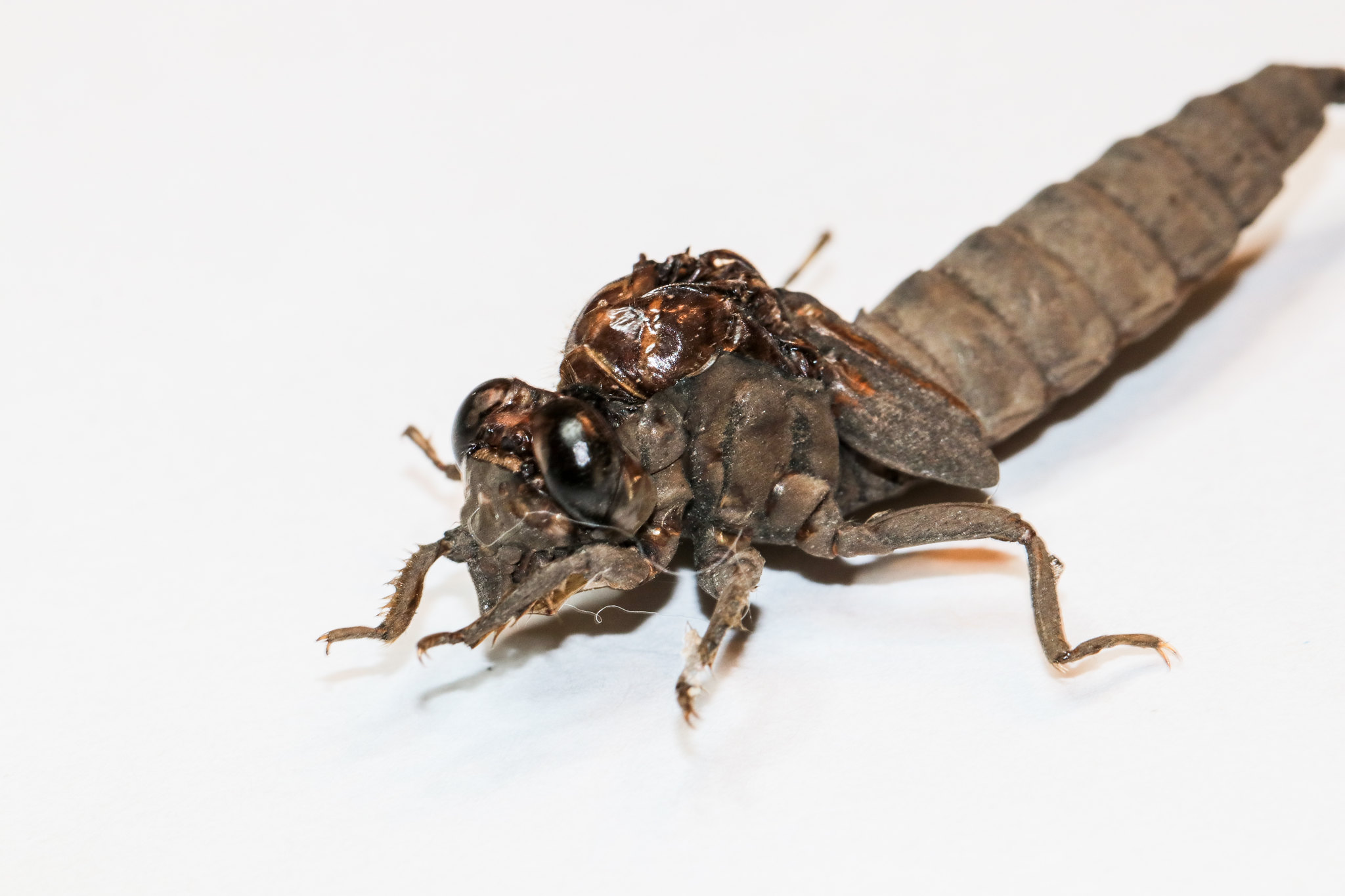Dragonfly and it's exuviae.
Jan 15, 2022 20:23:36 #
Dragonflies of different species lay their eggs in different ways - on plants, in water, in plants (in slits they make with their ovipositor) or splashed onto a wet muddy bank or moss colony. The eggs hatch in days or may overwinter in some species. The naiads will then grow and go through 5-17 instars where they will shed their outer skin (exuviae) over a period of several weeks to 5 years again depending upon species and latitude. When their growth is complete and the time is right they will climb a sturdy emergent plant or crawl out on the bank or on to a rock to emerge as an imago (adult dragonfly).
On a trip to Florida a friend gave me the exuviae of a dragonfly I went down there to photograph. I was late for their emergence but was there in the middle of the flight season.
The exuviae is that of a Two-striped Forceptail (Aphylla williamsoni). You can see the place where this dragon emerged if you look between the wings pads. From that 3/8" wing pad comes wings about 1 1/2". Amazing.
 Two-striped Forceptail (Aphylla williamsoni) by Tony Schoch, on Flickr
Two-striped Forceptail (Aphylla williamsoni) by Tony Schoch, on Flickr
 Two-striped Forceptail (Aphylla williamsoni) by Tony Schoch, on Flickr
Two-striped Forceptail (Aphylla williamsoni) by Tony Schoch, on Flickr
As you can see the last segment of the exuviae is quite long. This is quite unusual for this body segment.
Here is the adult of this species. It is quite easy to see the reason for the name forceptail.
 Two-striped Forceptail (Aphylla williamsoni) M by Tony Schoch, on Flickr
Two-striped Forceptail (Aphylla williamsoni) M by Tony Schoch, on Flickr
 Two-striped Forceptail (Aphylla williamsoni) M by Tony Schoch, on Flickr
Two-striped Forceptail (Aphylla williamsoni) M by Tony Schoch, on Flickr
Enjoy and have a great day!
>i< Doc
On a trip to Florida a friend gave me the exuviae of a dragonfly I went down there to photograph. I was late for their emergence but was there in the middle of the flight season.
The exuviae is that of a Two-striped Forceptail (Aphylla williamsoni). You can see the place where this dragon emerged if you look between the wings pads. From that 3/8" wing pad comes wings about 1 1/2". Amazing.
 Two-striped Forceptail (Aphylla williamsoni) by Tony Schoch, on Flickr
Two-striped Forceptail (Aphylla williamsoni) by Tony Schoch, on Flickr Two-striped Forceptail (Aphylla williamsoni) by Tony Schoch, on Flickr
Two-striped Forceptail (Aphylla williamsoni) by Tony Schoch, on FlickrAs you can see the last segment of the exuviae is quite long. This is quite unusual for this body segment.
Here is the adult of this species. It is quite easy to see the reason for the name forceptail.
 Two-striped Forceptail (Aphylla williamsoni) M by Tony Schoch, on Flickr
Two-striped Forceptail (Aphylla williamsoni) M by Tony Schoch, on Flickr Two-striped Forceptail (Aphylla williamsoni) M by Tony Schoch, on Flickr
Two-striped Forceptail (Aphylla williamsoni) M by Tony Schoch, on FlickrEnjoy and have a great day!
>i< Doc
Jan 15, 2022 20:28:10 #
Nature is not only weird but more weird than we can imagine!
Great photos!
Great photos!
Jan 15, 2022 20:30:11 #
Jan 15, 2022 20:48:34 #
Retired CPO wrote:
Nature is not only weird but more weird than we can imagine!
Great photos!
Great photos!
Thanks so much Chief and yes she has some very strange creatures. The more I study them the more amazed I am.
>i< Doc
Jan 15, 2022 20:50:42 #
Excellent photography and interesting narrative, Doc! Thanks for sharing.
Jan 15, 2022 20:54:16 #
Longshadow wrote:

Thanks for the thumb up Longshadow! Much appreciated.
>i< Doc
Jan 15, 2022 20:55:24 #
UTMike wrote:
Excellent photography and interesting narrative, Doc! Thanks for sharing.
You are quite welcomed Mike. Glad you enjoyed the set and the narrative,
>i< Doc
Jan 15, 2022 21:26:20 #
Jan 15, 2022 21:55:33 #
kpmac wrote:
Great set, Doc. And thanks for the narrative.
Hey Ken! Good to hear from you. So glad you enjoyed the set and the narrative. It's a strange looking exuviae. This one is easy to ID. Trying to ID some of them to species can be a real test of patience. Actually, calculus was easier.
>i< Doc
Jan 16, 2022 06:03:16 #
Jan 16, 2022 06:17:00 #
Jan 16, 2022 06:43:25 #
Jan 16, 2022 07:14:07 #
nimbushopper wrote:
Great set Doc!
Thanks for looking in Gary and for the fine comment. Much appreciated.
>i< Doc
Jan 16, 2022 07:15:16 #
Manglesphoto wrote:



I appreciate you taking the time to look in Frank. Have a great day!
>i< Doc
Jan 16, 2022 08:24:14 #
If you want to reply, then register here. Registration is free and your account is created instantly, so you can post right away.






